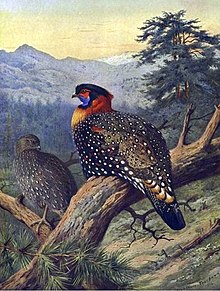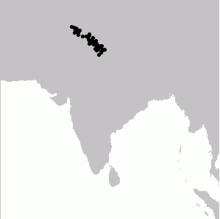
Himachal Pradesh is a state in the northern part of India. Situated in the Western Himalayas, it is one of the thirteen mountain states and is characterized by an extreme landscape featuring several peaks and extensive river systems. Himachal Pradesh is the northernmost state of India and shares borders with the union territories of Jammu and Kashmir and Ladakh to the north, and the states of Punjab to the west, Haryana to the southwest, Uttarakhand to the southeast and a very narrow border with Uttar Pradesh to the south. The state also shares an international border to the east with the Tibet Autonomous Region in China. Himachal Pradesh is also known as Dev Bhoomi or Dev Bhumi, meaning 'Land of Gods' and Veer Bhoomi which means 'Land of the Brave'.

The koklass pheasant is a species of gamebird, being closely related to progenitive grouse that lived during the Miocene. They are distantly related to pheasants and are most closely related to grouse and turkeys. Koklass are the only species in the monotypic genus Pucrasia. Both the words koklass and pucrasia have been onomatopœically derived from the bird's territorial call.

The cheer pheasant, also known as Wallich's pheasant or chir pheasant, is a vulnerable species of the pheasant family, Phasianidae. It is the only member in the genus Catreus. The scientific name commemorates Danish botanist Nathaniel Wallich.

The Kashmir flycatcher is a small passerine bird in the flycatcher family Muscicapidae. It breeds in the Northwest Himalayas and winters in southern India and Sri Lanka. It was formerly considered to be a subspecies of the red-breasted flycatcher, Ficedula parva, which is its closest living relative. Males are distinctive in having a blackish border to the reddish throat while the females can easily be confused with those of F. parva.

The Himalayan monal, also called Impeyan monal and Impeyan pheasant, is a pheasant native to Himalayan forests and shrublands at elevations of 2,100–4,500 m (6,900–14,800 ft). It is part of the family Phasianidae and is listed as Least Concern on the IUCN Red List. It is the national bird of Nepal, where it is known as the danphe or danfe, and state bird of Uttarakhand, India, where it is known as monal. The scientific name commemorates Lady Mary Impey, the wife of the British chief justice of Bengal, Sir Elijah Impey.

Blyth's tragopan or the grey-bellied tragopan, is a pheasant that is a vulnerable species. The common name commemorates Edward Blyth (1810–1873), English zoologist and Curator of the Museum of the Asiatic Society of Bengal.

The ultramarine flycatcher or the white-browed blue flycatcher is a small arboreal Old World flycatcher in the ficedula family that breeds in the foothills of the Himalayas and winters in southern India.

The state of Himachal Pradesh is spread over an area 55,673 km2 (21,495 sq mi) and is bordered by Jammu and Kashmir and Ladakh on the north, Punjab on the southwest, Haryana on the south, Uttarakhand on the southeast, a small border with Uttar Pradesh in the south, and Tibet on the east. Entire Himachal Pradesh lies in the mountainous Himalaya region, rich in natural resources

The dark-breasted rosefinch is a species of true finch in the monotypic genus Procarduelis. It is found in Bhutan, China, India, Laos, Myanmar, Nepal, Pakistan, Thailand, and Vietnam. Its natural habitats are boreal forests and subtropical or tropical high-altitude shrubland.

The pink-browed rosefinch is a finch in the family Fringillidae. The species was first described by Nicholas Aylward Vigors in 1831. It ranges across the northern regions of the Indian subcontinent, mainly in the Himalayas, and is migratory. It is found in Bhutan, Tibet, India, Nepal, and Pakistan. Its natural habitats are boreal forests and subtropical or tropical dry forests.

The black-and-yellow grosbeak is a species of finch native to the northern parts of the Indian subcontinent, primarily the lower and middle Himalayas. It is in the family Fringillidae.

The black-crested tit, also known as the spot-winged tit, is a bird in the family Paridae. It was formerly considered a species, but is now widely considered a subspecies of the coal tit.

The blue-fronted redstart is a species of bird in the family Muscicapidae, the Old World flycatchers. It breeds in central China and the Himalayas. Its natural habitat is temperate forests. The female is brownish-grey, with paler underparts.

The grey bush chat is a species of passerine bird in the family Muscicapidae. It is found in the Himalayas, southern China, Taiwan, Nepal and mainland Southeast Asia.

The golden bush robin or golden bush-robin was first discovered in 1845 by Brian Houghton Hodgson, a British naturalist.

The Himalayan woodpecker is a species of bird in the family Picidae. It is found in the northern regions of the Indian subcontinent, primarily the Himalayas and some adjoining areas, and ranges across Afghanistan, India, Nepal, Bhutan and Pakistan. Its natural habitats are boreal forests and temperate forests. The International Union for Conservation of Nature has assessed its conservation status as being of "least concern".

The Western Himalayan broadleaf forests is a temperate broadleaf and mixed forest ecoregion which is found in the middle elevations of the western Himalayas, including parts of Nepal, India, and Pakistan.

The 'Eastern Himalayan subalpine conifer forests is a temperate coniferous forests ecoregion which is found in the middle and upper elevations of the eastern Middle Himalayas, in western Nepal, Bhutan, northern Indian states including Arunachal Pradesh and Sikkim and adjacent Myanmar and China.

The Western Himalayan subalpine conifer forests is a temperate coniferous forests ecoregion of the middle and upper elevations of the western Middle Himalayas of Nepal, India, and Pakistan.

Tourism in Himachal Pradesh relates to tourism in the Indian state of Himachal Pradesh. This is popularly renowned for its Himalayan landscapes and popular hill-stations. Many outdoor activities such as rock climbing, mountain biking, paragliding, ice-skating, trekking, rafting, and heli-skiing are popular tourist attractions in Himachal Pradesh.

























